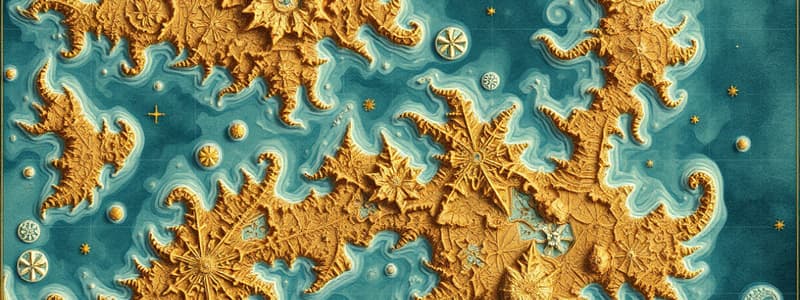Podcast
Questions and Answers
Which area in the figure is on a continental margin?
Which area in the figure is on a continental margin?
- Area D (correct)
- Area C
- Area B
- Area A
What is/are the advantage(s) of a multibeam sounder compared to traditional echo sounding?
What is/are the advantage(s) of a multibeam sounder compared to traditional echo sounding?
It provides a swath of measurements with each sweep of the seafloor, is more detailed, more accurate, and provides information about seafloor composition.
What is bathymetry?
What is bathymetry?
The study of the depth of the ocean.
If a sonar sounding had a total travel time of 5 seconds, what is the water depth?
If a sonar sounding had a total travel time of 5 seconds, what is the water depth?
Why is Greenland currently an area of active seafloor research?
Why is Greenland currently an area of active seafloor research?
What feature(s) can be recognized using multibeam sonar?
What feature(s) can be recognized using multibeam sonar?
Which statements accurately describe the depth and height of Earth's surface as shown on the hypsographic curve?
Which statements accurately describe the depth and height of Earth's surface as shown on the hypsographic curve?
Why is the average depth of the ocean much greater than the average height of land?
Why is the average depth of the ocean much greater than the average height of land?
In the figure, which area(s) represent(s) the middle of tectonic plates?
In the figure, which area(s) represent(s) the middle of tectonic plates?
In the figure, which area(s) represent(s) the abyssal plains?
In the figure, which area(s) represent(s) the abyssal plains?
To which planet is NASA sending the spacecraft InSight to study crustal movements similar to earthquakes?
To which planet is NASA sending the spacecraft InSight to study crustal movements similar to earthquakes?
Where would you expect to find a rift valley?
Where would you expect to find a rift valley?
Which of the following is an example of an active continental margin?
Which of the following is an example of an active continental margin?
What features are associated with a passive continental margin?
What features are associated with a passive continental margin?
What is a difference between passive and active continental margins?
What is a difference between passive and active continental margins?
Where would you expect to find graded bedding?
Where would you expect to find graded bedding?
How many turbidity currents created this sequence of turbidite deposits?
How many turbidity currents created this sequence of turbidite deposits?
How did turbidite deposits form?
How did turbidite deposits form?
Which color represents the continental shelf in the figure?
Which color represents the continental shelf in the figure?
Which statements are true regarding submarine canyons and turbidity currents?
Which statements are true regarding submarine canyons and turbidity currents?
Which location is an example of a fracture zone?
Which location is an example of a fracture zone?
Which statements are true regarding transform faults and fracture zones?
Which statements are true regarding transform faults and fracture zones?
Which label is located over a fracture zone in the figure?
Which label is located over a fracture zone in the figure?
Where is the Alpine Fault located?
Where is the Alpine Fault located?
The Dead Sea Fault separates which two tectonic plates?
The Dead Sea Fault separates which two tectonic plates?
Flashcards are hidden until you start studying
Study Notes
Continental Margins
- Dark blue areas on maps indicate deep water; lighter blue represents shallow water.
- Continental margin identified in area D of the figure.
Multibeam Sounder Advantages
- Offers a swath of measurements per seafloor sweep.
- Delivers more detailed, accurate data on seafloor composition.
Bathymetry
- Defined as the study of ocean depth.
Sonar Sounding and Water Depth
- Speed of sound in water is 1507 meters/second.
- A total travel time of 5 seconds corresponds to a water depth of 3767.5 meters (12,360.5 feet).
Research in Greenland
- Active research due to melting coastal glaciers driven by deep ocean currents.
- Insufficient documentation of coastal water depths surrounding Greenland.
Features Recognized by Multibeam Sonar
- Capable of identifying shipwrecks, seamounts, tablemounts, and ridge axes.
Hypsographic Curve Insights
- Ocean average depth exceeds average land height.
- More individuals have reached mountain peaks than the deepest ocean trenches.
- Approximately 29.2% of Earth's surface is above sea level.
Density of Crust
- Oceanic crust is denser than continental crust, leading to deeper oceans.
Tectonic Plate Characteristics
- Areas B and D represent the middle of tectonic plates on the hypsographic curve.
- Area D indicates abyssal plains.
NASA's InSight Mission
- Spacecraft is headed to Mars to study crustal movements similar to Earth’s earthquakes.
Rifts and Continental Margins
- A rift valley is expected in area B of the figure.
- Active continental margins are exemplified by the west coasts of the United States and Chile.
- Features of passive continental margins include continental rise and flat coastal terrain.
Passive vs. Active Continental Margins
- Active margins show steep continental slopes, while passive margins have gradual slopes.
Graded Bedding Locations
- Found in deep-sea fans.
Turbidite Deposits
- Formed from four turbidity currents in the observed sequence.
- Turbidites lithified into sandstone layers uplifted onto land.
Monterey Canyon Map
- Orange color designates the continental shelf.
Submarine Canyons and Turbidity Currents
- Deep-sea fans consist of layered turbidite deposits 1-2 kilometers thick.
- Submarine canyons incise both active and passive continental slopes.
Fracture Zones and Transform Faults
- Mendocino is identified as an example of a fracture zone.
- Crust on both sides of a fracture zone moves in the same direction, with transform faults classified as plate boundaries.
- The Alpine Fault is located in New Zealand.
- The Dead Sea Fault separates the Arabian and African tectonic plates.
Studying That Suits You
Use AI to generate personalized quizzes and flashcards to suit your learning preferences.




